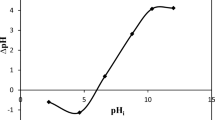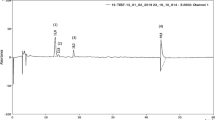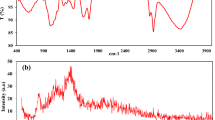Abstract
Phenolics have recently been of great concern because of the extreme toxicity and persistence in the environment. This study explores the possibility of using gastropod shell dust (GPSD) to remove phenol from aqueous solutions. The removal of phenol was investigated in batch mode. The influence of different experimental parameters—initial pH, adsorbent dose, initial concentration, contact time, stirring rate, temperature, and their interaction during phenol adsorption—were determined by response surface methodology based on three-level four-factorial Box–Behnken design. Optimized values of initial phenol concentration, pH, adsorbent dose, and contact time were found as 10.16 mg/L, 4.22, 0.50 g/L, and 33.47 min, respectively. The experimental equilibrium data were tested by four widely used isotherm models namely, Langmuir and Freundlich, D–R, and Temkin. It was found that adsorption of phenol on gastropod shell dust correlated with the Langmuir isotherm model, implying monolayer coverage of phenol onto the surface of the adsorbent. The maximum adsorption capacity was found to be 56.89 mg g−1 at 333 K. Regeneration study revealed that about 92 % phenol can be regenerate within 90 min from the spent GPSD. Kinetics of the adsorption process was tested by pseudo-first-order, pseudo-second-order kinetics, and intra-particle diffusion mechanism. Pseudo-second-order kinetic model provided a better correlation for the experimental data studied in comparison to the pseudo-first-order model. Intra-particle diffusion was not the sole rate-controlling factor. The activation energy of the adsorption process (E a) was found to be 2.68 kJ mol−1, indicating physisorption nature of phenol adsorption onto gastropod shell dust. A thermodynamic study showed spontaneous nature and feasibility of the adsorption process. A negative enthalpy (ΔH°) value indicated that the adsorption process was exothermic. The results revealed that gastropod shell dust can be used as an effective and low-cost adsorbent to remove phenol from aqueous solutions.















Similar content being viewed by others
References
Abdeen Z, Mohammad SG (2014) Study of the adsorption efficiency of an eco-friendly carbohydrate polymer for contaminated aqueous solution by organophosphorus pesticide. Open J Organic Poly Mater 4:16–28
Abdelkreem M (2013) Adsorption of phenol from industrial wastewater using olive mill waste. APCBEE Procedia 5:349–357
Ali A, Saeed K (2015) Phenol removal from aqueous medium using chemically modified banana peels as low-cost adsorbent. Desalination Water Treat. doi:10.1080/19443994.2015.1041057
Amin MN, Mustafa AI, Khalil MI, Rahman M, Nahid I (2012) Adsorption of phenol onto rice straw biowaste for water purification. Clean Technol Environ Policy 14:837–844. doi:10.1007/s10098-012-0449-6
Anastopoulos I, Kyzas GZ (2014) Agricultural peels for dye adsorption: a review of recent literature. J Mol Liq 200:381–389
Anirudhan TS, Radhakrishnan PG (2008) Thermodynamics and kinetics adsorption of Cu (ΙΙ) from aqueous solution on to a new cation exchanger derived from tamarind fruit shell. J Chem Thermodyn 40:702–709
Asma S, Zainal A (2009) Adsorption of phenol by activated carbon produced from decanter cake, Eng D thesis. University Malaysia Pahang, Pahang
Baquero MC, Giraldo L, Moreno JC, Suárez-García F, Martínez-Alonso A, Tascón JMD (2003) Activated carbons by pyrolysis of coffee bean husks in presence of phosphoric acid. J Anal Appl Pyrol 70:779–784
Chattoraj S, Mondal NK, Das B, Roy P, Sadhukhan B (2013a) Biosorption of carbaryl from aqueous solution onto Pistia stratiotes biomass. Appl Water Sci. doi:10.1007/s13201-013-0132-z
Chattoraj S, Mondal NK, Sadhukhan B (2013b) Predictability by Box-Behnken model for carbaryl adsorption by soils of Indian origin. J Environ Sci Health B 48:626–636
Chen Z, Ma W, Han M (2008) Bio sorption of nickel and copper on to treated alga (undaria pinnatifida): application of isotherm and kinetic models. J Hazard Mater 155:327–333
Chen H, Zhao J, Dai G, Wu J, Yan H (2010) Adsorption characteristics of Pb(II) from aqueous solution onto a natural biosorbent fallen Cinnamomum camphora leaves. Desalination 262(1–3):174–182
Daraei H, Mittal A, Noorisepehr M, Daraei F (2013) Kinetic and equilibrium studies of adsorptive removal of phenol onto eggshell waste. Environ Sci Pollut Res 20:4603–4611
Das D, Das N (2011) Response surface approach for the biosorption of Ag(I) by macrofungus Pleurotus platypus. CLEAN Soil Air Water 2:157–161
Din ATM, Hameed BH, Ahmad AL (2009) Batch adsorption of phenol onto physiochemical-activated coconut shell. J Hazard Mater 161:1522–1529
Djebbar M, Djafri F, Bouchekara M, Djafri A (2012) Adsorption of phenol on natural clay. Appl Water Sci 2:77–86
Dubinin MM, Radushkevich LV (1947) The equation of the characteristic curve of the activated charcoal. Proc Acad Sci USSR Phys Chem Sect 55:331–337
Fakhri A (2014) Application of response surface methodology to optimize the process variables for fluoride ion removal using maghemite nanoparticles. J Saudi Chem Soc 18:340–347
Freundlich HMF (1906) Over the adsorption in solution. J Phys Chem 57:385–470
Gao X, Zhai X, Wang Z, Fu F, Li W (2015) Effective adsorption of phenol from aqueous solutions on activated semi-coke. J Mater Sci 50:4200–4208
Giraldo JP, Landry MP, Faltermeier SM et al (2014) Plant nanobionics approach to augment photosynthesis and biochemical sensing. Nat Mater. doi:10.1038/NMAT3890
Girish CR, Murty VR (2014) Adsorption of phenol from aqueous solution using Lantana camara: Kinetics, isotherm, and thermodynamic studies. Int Sch Res Not. doi:10.1155/2014/201626
González PS, Ontañon OM, Armendariz A, Talano MA, Paisio CE, Agostini E (2013) Brassica napus hairy roots and rhizobacteria for phenolic compounds removal. Environ Sci Pollut Res 20:1310–1317. doi:10.1007/s11356-012-1173-9
Gundogdu A, Ozdes D, Duran C, Bulut VN, Soylak M, Senturk HB (2009) Biosorption of Pb(II) ions from aqueous solution by pinr bark (Pinus bruita Ten.). Chem Eng J 153:62–69
Ho YS, McKay G (1999) Pseudo-second order model for sorption processes. Process Biochem 34:451–465
Hossain A, Aditya G (2013) Cadmium biosorption potential of shell dust of the fresh water invasive snail Physa acuta. J Environ Chem Eng. doi:10.1016/j.jece.2013.06.030
Huang J, Jin X, Deng S (2012) Phenol adsorption on an N-methylacetamide-modified hypercrosslinked resin from aqueous solutions. Chem Eng J 192:192–200
Khare P, Kumar A (2012) Removal of phenol from aqueous solution using carbonized Terminalia chebula-activated carbon: process parametric optimization using conventional method and Taguchi’s experimental design, adsorption kinetic, equilibrium and thermodynamic study. Appl Water Sci 2:317–326. doi:10.1007/s13201-012-0047-0
Körbahti BK, Rauf MA (2008) Application of response surface analysis to the photolytic degradation of basic red 2 dye. Chem Eng J 138(1):166–171
Kumari AR, Babu UK, Sobha K (2011) Optimization of lead adsorption using animal biopolymers by factorial design. Int J Sci Innov Discover 1:303–319
Kundu S, Gupta AK (2006) Arsenic adsorption onto iron oxide-coated cement (IOCC): regression analysis of equilibrium data with several isotherm models and their optimization. Chem Eng J 122:93–106
Lagergenannten adsorption S (1998) Zurtheorie der sogelosterren adsorption gelosterstoffe, Kungliga Svenska Vetenkapsakademiens. Handlingar 24:1–13
Lal K, Garg A (2015) Catalytic wet oxidation of phenol under mild operating conditions: development of reaction pathway and sludge characterization. Clean Technol Environ Policy 17:199–210. doi:10.1007/s10098-014-0777-9
Langmuir I (1916) The constitution and fundamental properties of solids and liquids. J Am Chem Soc 38:2221–2295
Mall ID, Srivastava VC, Agarwal NK (2006) Removal of orange-G and methyl violet dyes by adsorption onto bagasse fly ash kinetic study and equilibrium isotherm analyses. Dyes Pigments 69:210–223
Mbui DN, Shiundu PM, Ndonye RM, Kamau GN (2002) Adsorption and detection of some phenolic compounds by rice husk ash of Kenyan origin. J Environ Monit 4:978–984
Mishra S, Bhattacharya J (2006) Potential of leaf litter for phenol adsorption-a batch study. Indian J Chem Technol 13:298–301
Mondal NK, Bhaumik R, Bour T, Das B, Roy P, Datta JK (2012a) Studies on defluoridation of water by tea ash: an unconventional biosorbent. Chem Sci Trans 1(2):239–256
Mondal NK, Bhaumik R, Banerjee A, Datta JK, Baur T (2012b) A comparative study on the batch performance of fluoride adsorption by activated silica gel and activated rice husk ash. Int J Environ Sci 2(3):1643–1661
Mondal NK, Das B, Bhaumik R, Bour T, Roy P (2012c) Calcareous soil as a promising adsorbent to remove fluoride from aqueous solution: equilibrium, kinetic and thermodynamic study. J Mod Chem Technol 3(3):1–21
Mondal NK, Bhaumik R, Roy P, Das B, Datta JK (2013) Investigation on fixed bed column performance of fluoride adsorption by sugarcane charcoal. J Environ Biol 34:1059–1064
Mondal NK, Bhaumik R, Das B, Roy P, Datta JK, Bhattacharyya S, Bhattacharjee S (2014) Neural network model and isotherm study for removal of phenol from aqueous solution by orange peel ash. Appl Water Sci. doi:10.1007/s13201-014-0188-4
Mustafa AI, Alam S, Amin N, Bahadur NM, Habib A (2008) Phenol removal from aqueous system by jute stick. Pak J Anal Environ Chem 9:92–95
Nadeem R, Hanif MA, Shaheen F, Perveen S, Zafar MN, Iqbal T (2008) Physical and chemical modification of distillery sludge for Pb(II) biosorption. J Hazard Mater 150(2):335–342
Namasivayam C, Sumithra S (2007) Adsorptive removal of phenols by Fe(III)/Cr(III) hydroxide, an industrial solid waste. Clean Technol Environ Policy 9:215–223. doi:10.1007/s10098-007-0085-8
Nath K, Panchani S, Bhakhar MS, Chatrola S (2013) Preparation of activated carbon from dried pods of Prosopis cineraria with zinc chloride activation for the removal of phenol. Environ Sci Pollut Res 20:4030–4045. doi:10.1007/s11356-012-1325-y
Oladoja NA, Aliu YD (2009) Snail shell as coagulant aid in the alum precipitation of malachite green from aqua system. J Hazard Mater 164:1496–1502
Pigatto G, Lodi A, Finocchio E Palma MS, Converti A (2013) Chitin as biosorbent for phenol removal from aqueous solution: equilibrium, kinetic and thermodynamic studies. Chem Eng Proc Proc Intensif 70:131–139
Radhika M, Palanivelu K (2006) Adsorptive removal of chlorophenols from aqueous solution by low cost adsorbent-kinetics and isotherm analysis. J Hazard Mater 138:116–124
Raut SK, Bhaumik S, Das S (1995) Occurrence of the snail physa acuta draparnaud in Calcutta, India. J Bom Nat Hist Soc 92:434
Rengaraj S, Moon S, Sivabalan R, Arabindoo B, Murugesan V (2002) Agricultural solid waste for the removal of organics: adsorption of phenol from water and waste water by palm seed coat activated carbon. Waste Manag 22:543–548
Rincón-Silva NG, Moreno-Piraján JC, Giraldo LG (2015) Thermodynamic study of adsorption of phenol, 4-chlorophenol, and 4-nitrophenol on activated carbon obtained from eucalyptus seed. J Chem. doi:10.1155/2015/56
Sadhukhan B, Mondal NK, Chattoraj S (2014) Biosorptive removal of cationic dye from aqueous system: a response surface methodological approach. Clean Technol Environ Policy 16:1015–1025
Saha P, Sanyal SK (2010) Reduction of lead pollution in groundwater using soil based protective liner bed in land fill pits. Desalination Water Treat 24:236–243
Sampedro I, Romero C, Ocampo JA, Brenes M, Habib A (2004) Removal of monomeric phenols in dry mill olive residue by saprobic fungi. J Agric Food Chem 52:4487–4492
Senthil kumaar S, Kalaamani P, Subburaam CV (2006) Liquid phase adsorption of crystal violet onto activated carbons derived from male flowers of coconut tree. J Hazard Mater 136(3):800–808
Senthilvelan T, Kanagaraj J, Panda RC, Mandal AB (2014) Biodegradation of phenol by mixed microbial culture: an eco-friendly approach for the pollution reduction. Clean Technol Environ Policy 16:113–126. doi:10.1007/s10098-013-0598-2
Srivastava VC, Swamy MM, Mall ID, Prasad B, Mishra IM (2006) Adsorptive removal of phenol by bagasse fly ash and activated carbon: equilibrium, kinetics and thermodynamics. Colloids Surf 272:89–104
Valili S, Siavalas G, Karapanagioti HK, Manariotis ID, Christanis K (2013) Phenanthrene removal from aqueous solutions using well-characterized, raw, chemically treated, and charred malt spent rootlets, a food industry by-product. J Environ Manage 128:252–258
Uday F, Alkaram AA, Mukhlis A, Al-Dujaili H (2009) The removal of phenol from aqueous solutions by adsorption using surfactant-modified bentonite and kaolinite. J Hazard Mater 169:324–332
Wang Q, Li Y, Li J, Wang Y, Wang C, Wang P (2015) Experimental and kinetic study on the cometabolic biodegradation of phenol and 4-chlorophenol by psychrotrophic Pseudomonas putida LY1. Environ Sci Pollut Res 22:565–573
Acknowledgments
This research was supported by the University of Burdwan under Science Faculty (No. 2012-2014/M.Sc. Dissertation).
Author information
Authors and Affiliations
Corresponding author
Ethics declarations
Conflict of interest
None.
Rights and permissions
About this article
Cite this article
Mondal, N.K., Roy, S. Optimization study of adsorption parameters for removal of phenol on gastropod shell dust using response surface methodology. Clean Techn Environ Policy 18, 429–447 (2016). https://doi.org/10.1007/s10098-015-1026-6
Received:
Accepted:
Published:
Issue Date:
DOI: https://doi.org/10.1007/s10098-015-1026-6




